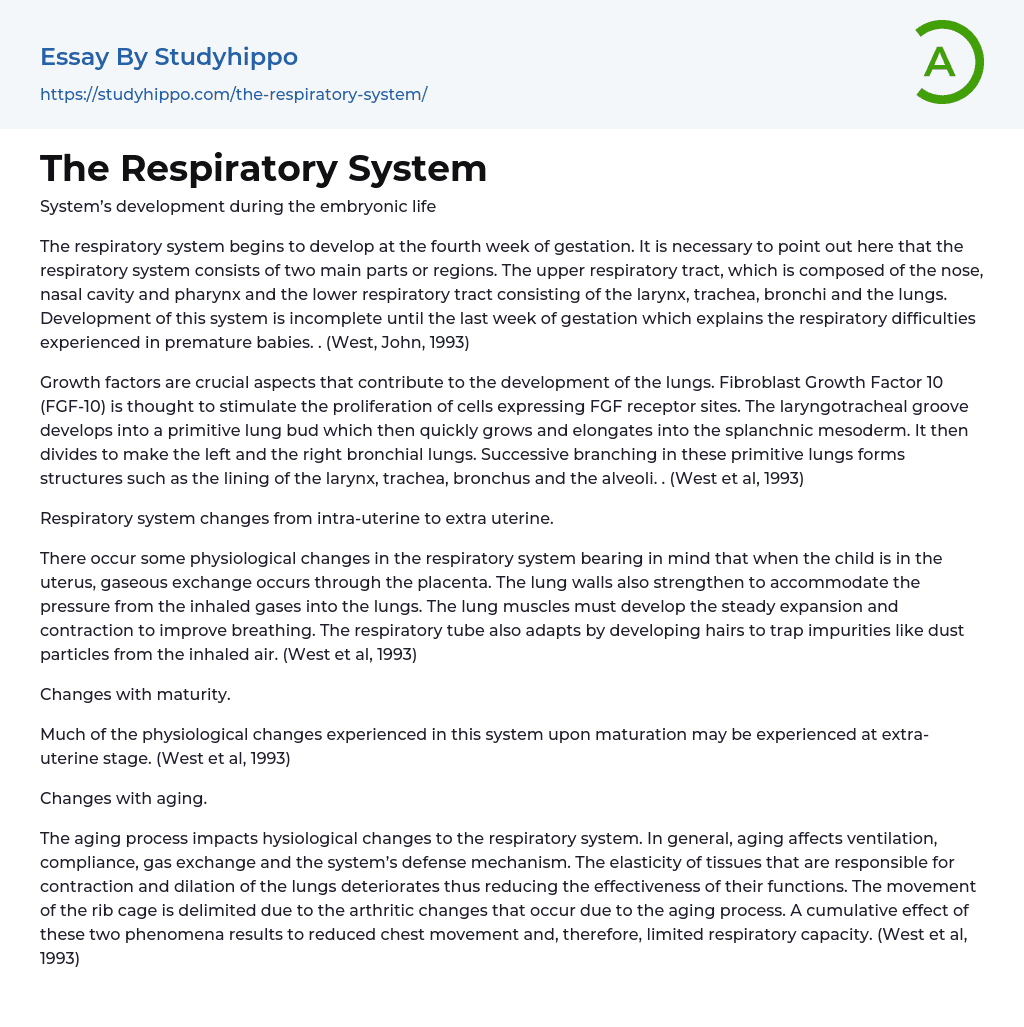During the fourth week of gestation, the respiratory system starts to develop in embryonic life. It comprises two main parts: the upper respiratory tract (nose, nasal cavity, and pharynx) and the lower respiratory tract (larynx, trachea, bronchi, and lungs). The development of this system remains incomplete until the final week of gestation, which is why premature babies often experience breathing difficulties. Growth factors like Fibroblast Growth Factor 10 (FGF-10) play a vital role in lung development by stimulating cell proliferation. The laryngotracheal groove transforms into a primitive lung bud in the splanchnic mesoderm. This bud grows rapidly and elongates before dividing into left and right bronchial lungs. Further branching within these early lungs gives rise to structures such as the lining of the larynx, trachea, bronchus, and alveoli.
After birth, there is a transition from intra-uterine to extra-uterine life for the re
...spiratory system. Various physiological changes occur as gaseous exchange no longer occurs through the placenta inside the uterus. Muscle development takes place alongside adaptation of the respiratory tube to facilitate improved breathing during maturation and aging. Physiological changes happen after birth as well when lung walls strengthen to tolerate inhaled gases. However, several factors impact lung function effectiveness with aging.
The elasticity of tissue deteriorates, which reduces lung function effectiveness. Additionally, arthritic changes in the rib cage limit movement, resulting in reduced chest movement and limited respiratory capacity. The respiratory system is prone to problems such as asthma and bronchitis, which can cause airway blockage and difficulty breathing. Emphysema, a condition attributed to aging, leads to the loss of elasticity in the walls of air sacs. Lung cancer may also occur due to malignant tumors, while
pleurisy is associated with inflammation of the pleural membrane. Other respiratory problems include viral infections like influenza, sinusitis, and common cold. Influenza is caused by the influenza virus while common cold stems from a virus belonging to rhabdovirus family. Sinusitis refers to mild inflammation of sinus cavities (West et al., 1993). During fertilization process only one sperm cell is permitted to enter the oocyte. If more than one sperm enters it would result in an excessive number of chromosomes in the fertilized egg hindering embryo development (Pinon, 2006). However for final stage of fertilization several hundred or thousands of sperms are necessary as they aid breaking down jelly coating around ovum through enzymatic effects (Pinon, 2006). Polyspermy refers to the fertilization of an egg by multiple sperms, resulting in a zygote that carries multiple copies of each chromosome from both the female and each sperm involved (Pinon, 2006). This type of zygote is considered nonviable.
The role of genes in regulating cell division and differentiation is crucial for ensuring controlled proliferation, preventing uncontrolled cell growth that can lead to tumor formation. After the demise of the corpus luteum, it transforms into fibrous scar tissue called corpus albicans. The restoration of an organism's diploid nature occurs during fertilization when sperm and egg cells merge, with the resulting zygote inheriting one pair of chromosomes from each parent. The sex chromosomes inherited determine whether the organism will be male or female: females have XX sex chromosomes while males have XY sex chromosomes. If a father contributes an X chromosome, the organism will develop as a female (XX), whereas receiving a Y sex chromosome leads to male development (XY). In
addition to determining sex, various characteristics are also inherited from parents' genes, leading to variation.
Undernutrition has significant effects on brain development and intellectual capacity. It causes a decrease in glial cell quantity and can result in reduced intellectual capacity for individuals. Inadequate nutrition during fetal development greatly delays myelination process and subsequently slows down brain development. Moreover, undernutrition hampers axonal and dendritic processes' growth, further impeding brain development. Research conducted by Pinon in 2006 revealed that undernutrition leads to a decrease in synapses per neuron, which consequently causes decreased motor coordination in individuals.
- Microbiology essays
- Bacteria essays
- Cell essays
- Enzyme essays
- Photosynthesis essays
- Plant essays
- Natural Selection essays
- Protein essays
- Viruses essays
- Cell Membrane essays
- Human essays
- Stem Cell essays
- Breeding essays
- Biotechnology essays
- Cystic Fibrosis essays
- Tree essays
- Seed essays
- Coronavirus essays
- Zika Virus essays
- Male essays
- Same-Sex Marriage essays
- Masturbation essays
- Apoptosis essays
- Asthma essays
- Black Death essays
- Breast Cancer essays
- Cholesterol essays
- Chronic essays
- Chronic Pain essays
- Death essays
- Diabetes essays
- Down Syndrome essays
- Epidemic essays
- Hypertension essays
- Infection essays
- Infertility essays
- Myocardial Infarction essays
- Pain essays
- Pathogen essays
- Pregnancy essays
- Sexually Transmitted Disease essays
- Symptom essays
- Tuskegee Syphilis Experiment essays
- Water supply essays
- Agriculture essays
- Albert einstein essays
- Animals essays
- Archaeology essays
- Bear essays
- Biology essays




